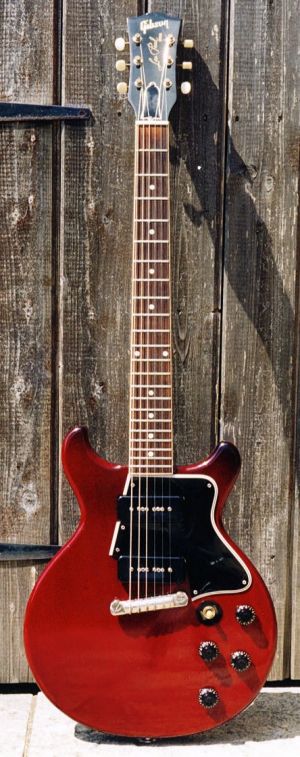
I've sung the praises of Gibson's original Les Paul guitars previously in these pages, and there's little to add except to present this neat example from the last days of production, when the company was in a period of upheaval attempting to keep up with rapidly changing market trends. The double cutaway design had been introduced in 1958 at the behest of players who wanted easier access to its upper frets; by 1961, a completely new, slim-line Les Paul model had been launched as the SG, which was an immediate success. Meanwhile, the factory had a ton of unsold original Les Pauls to dispose of.
The Les Paul Special became a problem for the designers after the second cutaway had been introduced. Firstly, the neck pickup was located ¼" from the point where the neck meets the body, requiring a cavity to be cut to accommodate it, resulting in a very weak joint. Necks soon began parting company with bodies, so by 1959 the pickup had been relocated 1" back and the neck moved one upper-fret's width further into the body; the bridge was also moved back slightly (compare the Special with the Junior, below). The original control layout, which placed the pickup selector switch an inch or two behind the bridge (requiring a very large rout in the back of the guitar), was also changed, the neck pickup's controls and the switch now aligned vertically. At the same time, the "Les Paul" logo disappeared from the head stock. Why this happened is a mystery, since it remained in place on all the other models, including the early SG Juniors. My personal theory is that Gibson, having suffered considerable embarrassment over the neck fracture problem, perhaps felt that the model's association with the good name of Les Paul was a litigious time-bomb, particularly as the man himself was not consulted over the initial design changes and is now known to have disapproved. Pedants might question whether the instrument is actually a Les Paul at all!
This guitar's 5-figure etched serial number places its manufacture towards the end of 1961, when production of SG's was well under way. Yet all the control pots are dated February 1960, and are from the same batch. Also, those solid black knobs had virtually vanished by the fall of 1960, to be replaced by skirted knobs with silver tops. They could easily be replacements, though appear to be original.
So at what stage in the manufacturing process did the necks receive numbers? Presumably not after they had been sprayed? Perhaps, during Gibson's move into its expanded premises in the summer of 1960, a number of ready-assembled wiring looms were put into storage only to re-appear at some later date for assembly into finished instruments. Answers on a post-card, please.
These wonderful guitars sound amazing and are a joy to play. I particularly like the sound of the relocated pickup. With both units active, the guitar produces a beautiful chimey timbre, a characteristic in common with the first SG Specials, whose pickups are similarly spaced. The neck is very shallow, like a mid-60's SG Standard, and the chunky-but-light mahogany body combines with the simple wrap-over stud bridge to produce tone that sustains forever. This guitar has been re-finished in its original cherry colour quite professionally, though in common with virtually all non-factory re-fin jobs, lacks those oh-so-necessary extra coats of clear nitro that separates the butter from the Stork. However, neither sound nor playability has suffered at all, and it's nice that whoever did it restored the logo to the head veneer!